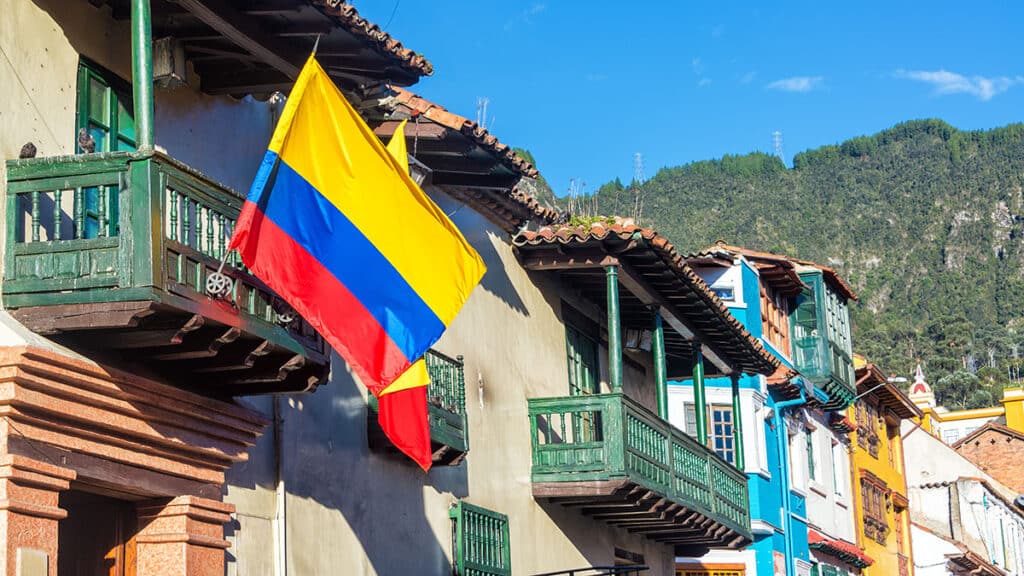Colombian Independence Day on July 20 marks the day in 1810 when protests in Bogotá, the capital, led to the formation of an independent government and ultimately to independence from Spain.
Colombian Independence Day NYC 2024

The next Colombian Independence Day is Sunday, July 20, 2024.
Colombian Culture in July
For some reason, there is a lot of Colombian culture in July.
- The Feast of Our Lady of Chiquinquirá, patron saint of Colombia is July 9. 🇨🇴
- The Festival de las Flores, New York’s version of Medellín’s Feria de las Flores is in Jackson Heights, Queens, usually on the Sunday before Colombian Independence Day. 🇨🇴
- Colombian Independence Day is July 20, 1819. 🇨🇴
- Colombian Independence Festival brings salsa and ranchera stars to Prudential Center in Newark, New Jersey. 🇨🇴
- NYC”s Colombian Day Parade is in Jackson Heights, Queens on a Sunday near July 20. 🇨🇴
- The Festival Independencia Orgullo Colombiano is in Flushing Meadows Corona Park, on a Sunday near Colombian Independence Day. 🇨🇴
- Simón Bolivár, the founding father of Colombia, was born in Caracas, Venezuela, on July 24, 1783. 🇨🇴
Colombian Independence Day
A few Spaniards ruled millions of Latin Americans through a strict and cruel caste system. Spanish-born Spaniards held the highest rank. American-born Spaniards or Criollos (Creoles) held the second rank. Indigenous and enslaved people were the lowest rank.
The Spanish-born did whatever they wanted with the people and stole great wealth from the land. Eventually this created a lot of tension. Napoleon’s invasion of Spain in 1808 created the opening for independence movements across Latin America. The imprisonment of Spanish King Ferdinand VII gave Criollos the justification for their first steps towards self-rule.
It’s interesting that the French, known for breaking down their own feudal system, directly or indirectly influenced independence movements across the Americas.
The official movement towards Colombian independence from Spain began in the capital of Bogotá. This was important because Bogotá was one of the four capitals from which Spain ruled all of Latin America. Colombia at the time was Gran Colombia which covered the entire northern section of South America including what are now the countries of Panama, Ecuador, and Venezuela.
Trouble was brewing everywhere. The people of Quito (Ecuador) revolted in 1809. Caracas (Venezuela) declared independence in April, 1810. Cartagena (Colombia) declared independence in May.
Leaders in Bogotá stirred up a riot over complaints about a flowerpot and the Spanish Viceroy’s subsequent refusal to allow the formation of a local government.
The battle for Colombian independence continued until Simón Bolívar entered Bogotá in 1819 after the Battle of Boyocá.
The yellow in the Colombian flag represents the country’s riches. The blue represents the seas and rivers that support the people. The red in the flag represents the blood spilled for the independence of Colombia and all people.
On Colombian Independence Day, July 20, remember the sacrifices of so many under the leadership of patriots like Camilo Torres Tenorio, Luís Rubio, Joaquín Camacho, José María Carbonell, José Acevedo y Gómez, and many others including common people.
Though we salute the patriot’s initiative, let us not repeat their mistakes. We should stand together in the vision of Simón José Antonio de la Santísima Trinidad Bolívar y Palacios (Simón Bolívar) that freedom is for all people regardless of race, origin, or status.
It takes many generations to build a nation. We believe the destiny of Colombia is yet to be fulfilled, but it is coming. In the vision of the founding fathers, Colombia’s destiny is for all people.
They don’t make them like Simón Bolívar any more
Simón Bolívar (El Libertador, the liberator) is the founding father (the George Washington) of Venezuela, Colombia, Panama, Ecuador, Peru, and Bolivia. Bolívar was born in Caracas. This made him Criollo, an American-born Spaniard. Bolívar’s family controlled many of the copper mines in what is now Venezuela. He was raised by a black enslaved woman named Hipólita who became even more important when he was orphaned at age nine. Bolívar was educated in Europe.
Bolívar is in the line of Gilbert du Motier the Marquis de Lafayette, George Washington, Thomas Jefferson, and Benjamin Franklin. However Bolívar’s vision was freedom for all people, regardless of race. In this way he went further than our founding fathers of the United States.
We are pretty sure that Bolívar’s concept of freedom for everyone came from the woman who raised him, his nurse and then stepmother Hipólita. Interestingly Hipólita’s name comes from Greek mythology where “Hippolyta” was an Amazonian queen with a magic girdle. Bolívar called her, “the only mother I have known.” So a black slave woman is the mother of Latin American independence. How about that?
There is a statue of Simón Bolívar in Central Park near 57th Street.
